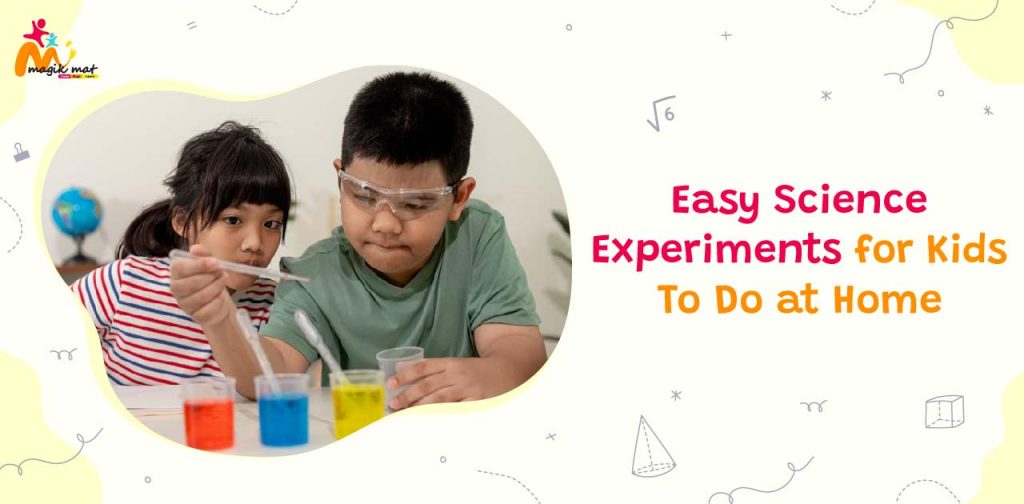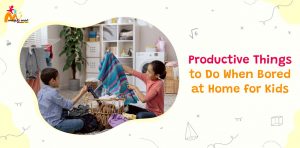Introduction
Explaining science to children through easy, hands-on experiments they can perform at home is one of the best ways to spark their interest. These experiments not only make science fun but also provide valuable learning experiences. In this blog, we will explore various simple science activities that kids can do at home, making learning engaging and interactive.
This hands-on approach allows children to gain scientific knowledge through practice. Science experiments help them understand scientific concepts, develop reasoning skills, and nurture their curiosity. All the experiments featured in this blog are safe, easy, and enjoyable, using common household items. Whether you’re a parent, looking to keep your kids engaged on rainy days or a teacher seeking fun and educational science activities, you’ll find excellent experiments to try here.
Five Easy Science Experiments for Kids
- Baking Soda and Vinegar Volcano
This classic experiment is a fun and engaging way to teach children about chemical reactions. By combining baking soda and vinegar, you can create a miniature volcano eruption that captivates and educates.
This science project is probably one of the most popular experiments in school, as it is a simple experiment that shows a chemical reaction between baking soda and vinegar and makes a sort of ‘volcano’.
Materials:
- Baking Soda
- Vinegar
- Dish Soap
- Food Colouring (Optional)
- A Small Container or Bottle
- A Tray or Dish to Catch the Overflow
This simple and popular science project demonstrates a chemical reaction between baking soda and vinegar, producing a volcanic eruption effect. It’s a great way to introduce kids to the basics of chemistry enjoyably and memorably.
Steps:
- Place the container on the tray to catch any overflow.
- Add a few tablespoons of baking soda to the container.
- For added effect, mix in a few drops of dish soap and food coloring.
- Pour vinegar into the container and watch the “volcano” erupt!
Explanation:
When baking soda (a base) reacts with vinegar (an acid), it produces carbon dioxide gas. This gas creates bubbles and fizzing, causing the eruption effect in the volcano.
- The Magic Milk Experiment
This colorful experiment illustrates the principles of chemical reactivity, showcasing how soap interacts with fat molecules in milk.
Materials:
- Whole Milk
- Food Colouring
- Dish Soap
- A Shallow Dish or Plate
- Cotton Swabs
Steps:
- Pour the milk into the dish to create a layer covering the bottom.
- Add several drops of different food colouring to the milk.
- Dip a cotton swab in dish soap and lightly touch it to the surface of the milk.
- Watch as the colors swirl and move around, creating mesmerizing patterns.
Explanation:
Whole milk contains fat molecules, and dish soap breaks down these fat molecules. As the soap interacts with the fat, it causes the food colouring to move and create dynamic, colorful patterns on the milk’s surface.
- Homemade Lava Lamp
This experiment demonstrates concepts of density and the interaction between oil and water.
Materials:
- A Clear Bottle or Jar
- Water
- Vegetable Oil
- Food Colouring
- Alka-Seltzer Tablets
Steps:
- Fill the bottle about two-thirds full of water.
- Add a few drops of food colouring to the water and mix.
- Pour vegetable oil into the bottle, leaving some space at the top.
- Break an Alka-Seltzer tablet into small pieces and drop them into the bottle one by one.
- Watch as the coloured water forms bubbles and rises through the oil.
Explanation:
Water and oil don’t mix due to their different densities. When the Alka-Seltzer tablet is added, it reacts to produce carbon dioxide gas. This gas forms bubbles that lift the colored water through the oil, creating a lava lamp effect.
- Rainbow in a Jar
This experiment demonstrates how liquids of different densities can form distinct layers when combined.
Materials:
- A Clear Jar
- Honey
- Corn Syrup
- Dish Soap
- Water
- Vegetable Oil
- Rubbing Alcohol
- Food Colouring
Steps:
- Carefully pour each liquid into the jar in the following order: honey, corn syrup (colored with food coloring), dish soap, water (colored with food coloring), vegetable oil, and rubbing alcohol (colored with food coloring).
- Pour each liquid slowly down the side of the jar to prevent mixing.
- Observe the formation of colorful layers, creating a rainbow effect.
Explanation:
Each liquid has a different density. The denser liquids settle at the bottom, while the lighter liquids float on top, creating distinct layers. The liquids do not mix due to their differing densities.
- Balloon Rocket
This experiment demonstrates Newton’s Third Law of Motion, which states that for every action, there is an equal and opposite reaction.
Materials:
- A Balloon
- A Long, Narrow Piece of String
- A Straw
- Tape
Steps:
- Thread the string through the straw.
- Stretch the ends of the string between two poles, such as chairs.
- Inflate the balloon but do not tie it. Tape the balloon to the straw without tying it.
- Release the air from the balloon and watch as the balloon moves along the string.
Explanation:
As the air escapes from the balloon, it exerts a force in the opposite direction of the balloon’s movement. This reaction force propels the balloon along the string, illustrating Newton’s Third Law of Motion.
Incorporating educational technology products like Magik Mat can significantly enhance kids’ learning experiences. Magik Mat combines fun and effectiveness, making it an excellent tool for education. It features a wide range of games focused on Mathematics and English, covering topics such as counting, addition, subtraction, and the alphabet. By connecting the mat with a screen, children can actively engage in these games by jumping on the mat, turning learning into a fun physical activity. Reviewers have evaluated Magik Mat for child development and verified it as a safe and effective Edutech product.
Conclusion
Science experiments are valuable approaches to teaching kids and helping them grasp scientific concepts more effectively. This blog highlights experiments that use easy-to-find, non-hazardous materials, making them safe to conduct at home. Additionally, incorporating Edutech products like Magik Mat can further enhance children’s learning by developing a wide range of skills playfully.
By making science fun and accessible, we can inspire a lifelong love for learning and exploration. So, gather your materials, set up your experiments, and enjoy watching your kids discover the wonders of science right at home. Happy experimenting!





